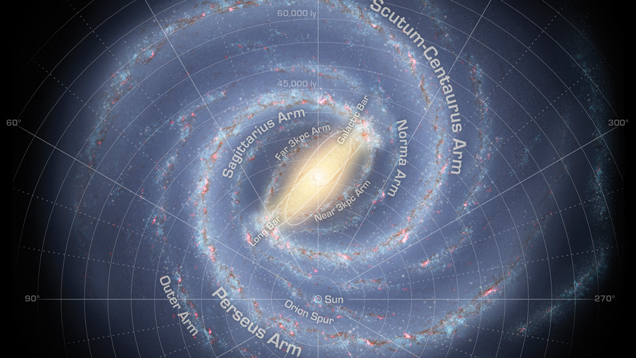Previously thought old and dead, the Milky Way's core is making stars again
 CREDIT: NASA / JPL-CALTECH
CREDIT: NASA / JPL-CALTECHCertain regions of the Milky Way are producing new stars, with scientists discovering stars as young as 25 million years old.
While the International Space Station (ISS) and international partners celebrate 15 years of continuous human presence in space and the data analyzed from Jupiter’s icy moon revealing a previously unknown chemical seeping from the cracks on it’s icy surface, the Earth is churning out new, sometimes weird discoveries.
Milky Way’s core
Astronomers studying a class of pulsating stars named Cepheid’s were surprised by their discovery.
Cepheid’s type of star expands and contracts on a very precise schedule; it increases and decreases with these size changes and with it changes the brightness of the star.
Astronomers were using this information to begin making a three-dimensional star chart of previously unknown regions of the Milky Way galaxy. The project was endorsed and funded by the European Southern Observatory, and was conducted at the Chilean Vista Observatory.
Because these stars are so close together, the centre of the Milky Way in an area called the galactic bulge is very hard to image and measure any data. This is because the enormous gravitational effects pull cosmic matter towards it, obscuring any pictures.
The solution was to take large high-resolution images in the infrared range of the light spectrum, allowing cosmic structures and objects behind the dust to be seen and imaged.
The real surprise was when astromers found a new region in and around the galactic bulge, which housed extremely young stars, some only 25 million to 100 million years old. For reference, most stars range from one to10 billion years old.
The find was interesting because researchers now need to figure out how some of the youngest stars in our galaxy are being born in an area that has some of the galaxies oldest matter.
For now, researchers will have to be content with the emerging three-dimensional image of the Milky Way and its mysterious galactic core.
E-skin
South Korean researchers have made a new material that could hold enormous potential for the biomedical industry.
The new material, dubbed an e-skin, mimics how human skin works, which they stated in their research was the breakthrough. They went on to state their work was the first to be flexible, compact and light enough to truly act like human skin, without bulky external sensors attached.
Human skin relies on fingerprints and biosensors to send information about our environment back to our brain.
The new system works the same, using different electronic principles to receive and send pressure, temperature and multiple types of touch back to a computer.
Other uses noted in the research included flexible accurate biosensors measuring cardiovascular issues, removing the need for bulky monitors to be carted around with patients and measuring pressure and frequency of incoming acoustic waves.
The researchers hope to one-day use this technology to create more humanoid robots, but the new sensors could go much farther. They could possibly be used to give amputees and burn victims a range of senses again to affected regions.
Hybrid
Closer to home, a long-term census coming from Gatineau Park in Quebec, a National Park bordering Ottawa’s northern side, is giving ecologist’s and scientists a pause for thought.
After several years of study, it was determined that between 15 and 30 animals in the park have both coyote and eastern wolf DNA.
One male, while being the size of a wolf, had almost entirely coyote DNA, and was paired with another coyote-wolf hybrid.
While hybrid animals are known to happen, in the wild, these creatures usually die out due to genetic or infertility issues, stopping the progression of hybrid genes.
The animals are also raising questions on whether to protect these animals since the eastern wolf is an endangered species. Park officials are worried about what will happen to them when they travel out of the park.
New electronic skin, new stars, and a possible new subspecies of wolf all dot this week’s science, but more scientific information was also release. This list includes studies on keeping tourist ice caves from melting and striking new images of Saturn’s moons, Enceladus. It’s a busy universe.














